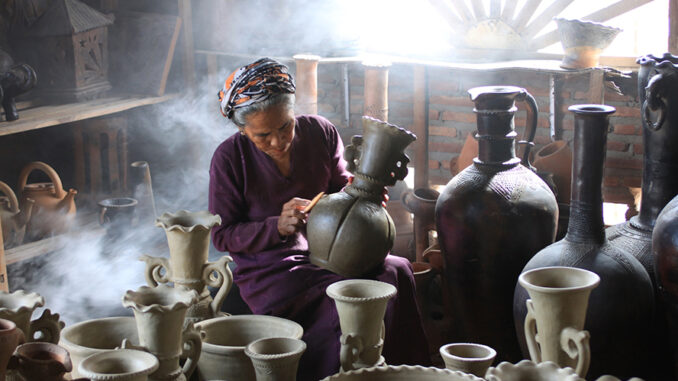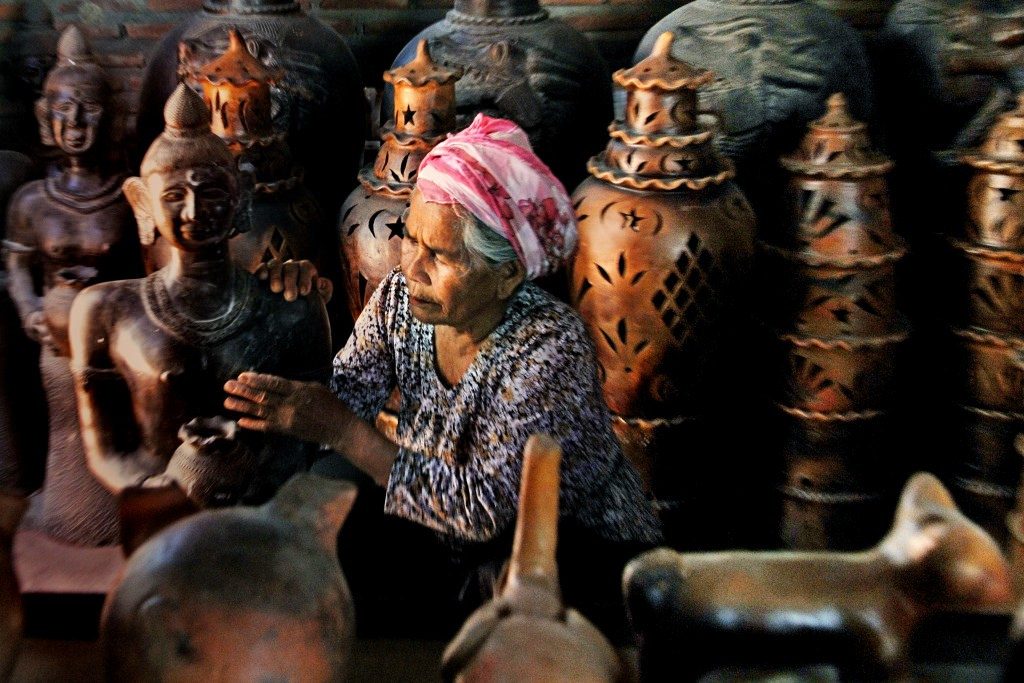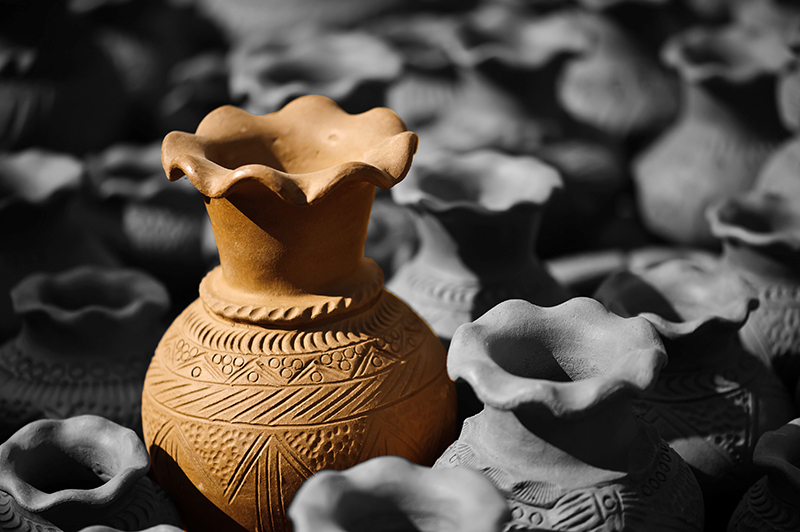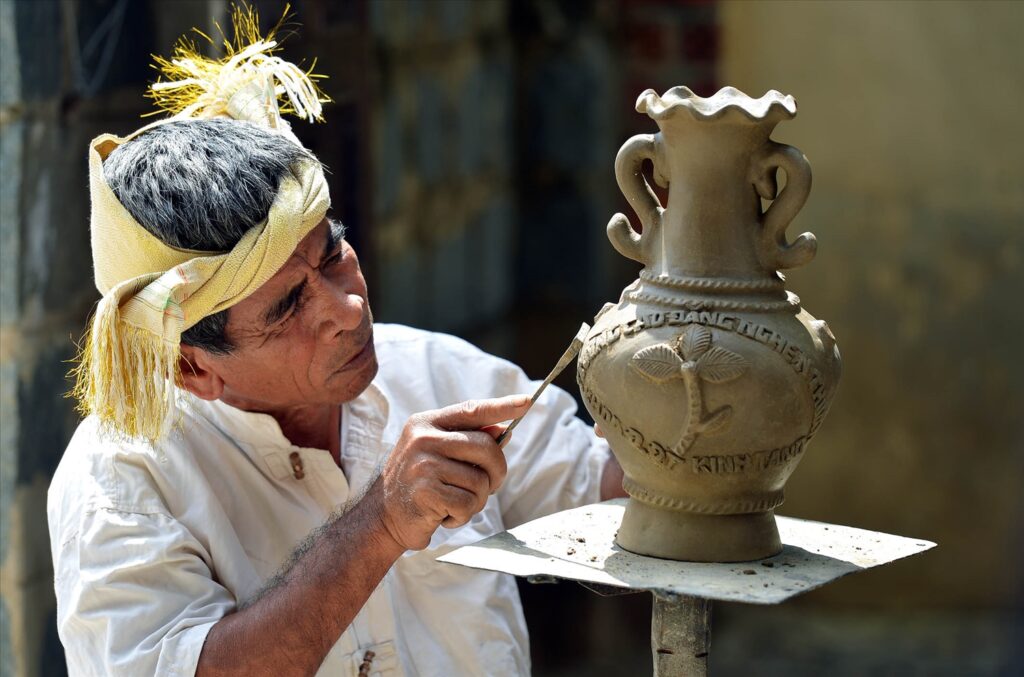
The Art of Pottery-making of Cham People is a traditional craft that has been practiced in Vietnam for centuries. The Cham people are an ethnic minority group that lives in the central and southern regions of the country. Their pottery is known for its unique style and high quality.
Cham pottery products are mainly household utensils, religious objects, and fine artworks, including jars, pots, trays, and vases. They are made by women and viewed as an expression of individual creativity based on the knowledge transmitted within the community. Instead of using a turntable, the women revolve around the piece to shape it. The pottery is not glazed but fired outdoors with firewood and straw for seven to eight hours at a temperature of about 800 degrees Celsius. Raw materials (clay, sand, water, firewood, and straw) are collected locally, and the knowledge and skills are passed on to younger generations within families through hands-on practice.
History
The process of developing pottery by the Cham people in Binh Thuan and Ninh Thuan provinces to date has not been fully, clearly, and specifically mentioned in any document. Even the elderly ceramic artists and Cham dignitaries do not know the origin of their ethnic pottery. Documents in ancient Cham script also do not mention this issue. There are also no inscriptions or folk legends related to pottery that have been passed down in the Cham community.

This pottery village is now mainly present in two villages: Ligok (Tri Duc, now Binh Duc, Binh Thuan province) and Hamu Crok (Bau Truc, Ninh Thuan province). Existing since the late 12th century until now, Bau Truc is considered one of the very few ancient pottery villages in Southeast Asia that still retains rudimentary production methods from ancient times.
Unique feature
The entire pottery-making process of the Cham people exudes a unique artistic value. The most unique feature of the Cham pottery village is that the people involved in creating pottery are all women, and they move in a circle around the pottery table, not rotating the pottery table like other places.
Raw materials for making pottery by the Cham people of Bau Truc village include clay, sand, and freshwater, in which the clay in Bau Truc village, with its special adhesion, makes an important contribution to creating the uniqueness of Bau Truc ceramic products. This is a very important step in the process of creating Bau Truc ceramic products.
The potter creates patterns on the ceramic body from very simple objects, such as seashells to stamp on the ceramic body, iron rods, brushes, and sometimes the inside of a pen to draw circles around the body of the shirt, pottery, or triangles, flowers, and plants. Sometimes it’s even a broken comb tooth to decorate water waves with beautiful and strange shapes…

Bau Truc Cham ceramics abstain from animal and human-shaped patterns. They believe that drawing human and animal images on pottery when the pottery is fired is like putting human and animal images on the funeral pyre of the Cham Brahmins (because the Cham people of Bau Truc village are the Ahier Cham community according to cremation custom).
In addition, the special thing is that the pottery here will be fired outdoors, so the worker must arrange the firing materials (firewood, straw, and rice husk) into certain layers. Then stack the ceramics and ingredients on top of each other and start firing. The entire pottery-making process of the Cham people exudes a unique artistic value.
Thanks to that, despite many ups and downs in the process of development, traditional Cham pottery still exists over time, retaining its quintessential soul and preserving the wild beauty of ancient pottery from hundreds of years ago. That is the unique and lasting value of Cham ceramics.
Preservation pottery village
Currently, the number of artisans, practitioners, and apprentices in pottery villages is still small. Despite many efforts to protect it, the heritage is still at risk of being lost due to many different threats, such as urbanization affecting the space of traditional craft villages and affecting the availability of raw materials, rising costs of raw materials, the advanced age of skilled artisans, the younger generation not being interested in the profession, and a lack of product diversity.

Currently, the community tourism development project has helped people have more livelihoods, generate income from sustainable tourism development, protect the environment, and preserve and promote the value of the nation’s cultural heritage. People are supported with training in tourist service skills such as welcoming guests, making traditional dishes, and introducing and promoting products. Exploiting Cham ceramics in tourism services is also a way to encourage young people in pottery villages to love the profession and continue the traditional profession of their ancestors.
Conclusion
The art of pottery-making of Cham people was officially registered by UNESCO on the List of Intangible Cultural Heritage in Need of Urgent Protection. This is Vietnam’s 15th intangible cultural heritage inscribed on UNESCO’s List.
This achievement affirms international appreciation for Cham ceramic art and Vietnamese cultural values; contributing to enriching the cultural diversity of Vietnam in particular and the world in general. The registration of Cham ceramic art also contributes to introducing the quintessence of national culture, promoting the image of a dynamically developing country and people of Vietnam, but still rich in tradition and imbued with identity.
Cham Pottery becomes an Intangible Cultural Heritage that needs urgent protection, creating more resources to preserve and promote the value of this heritage, and supporting economic and cultural development in a sustainable and inclusive direction. in localities and residential communities.
Get an opportunity to visit Intangible World Cultural Heritage in Vietnam through Vietnam E-Visa!